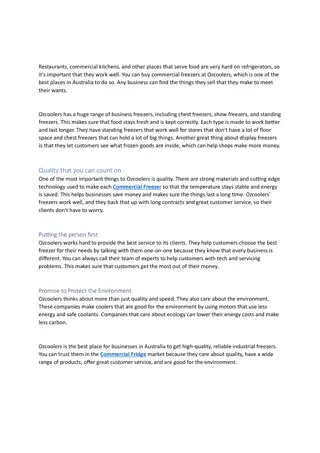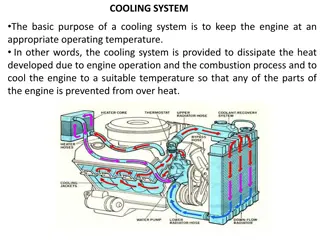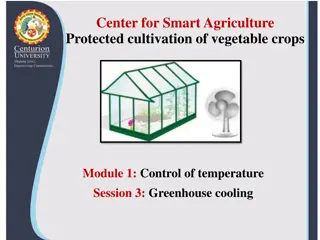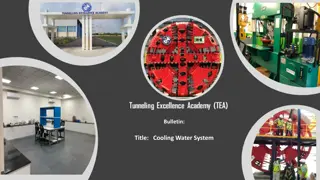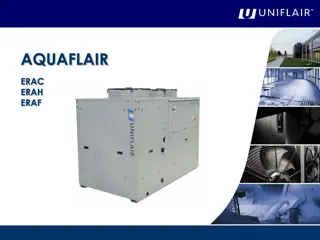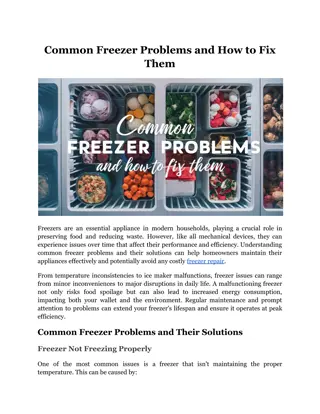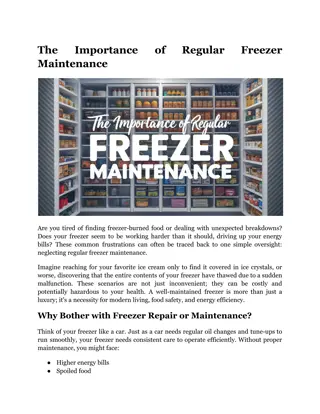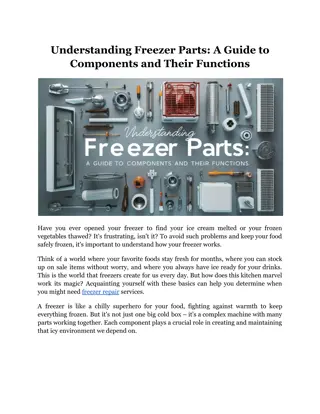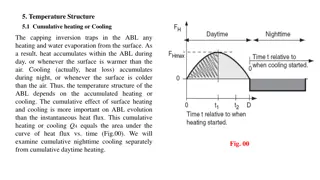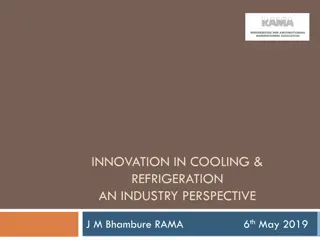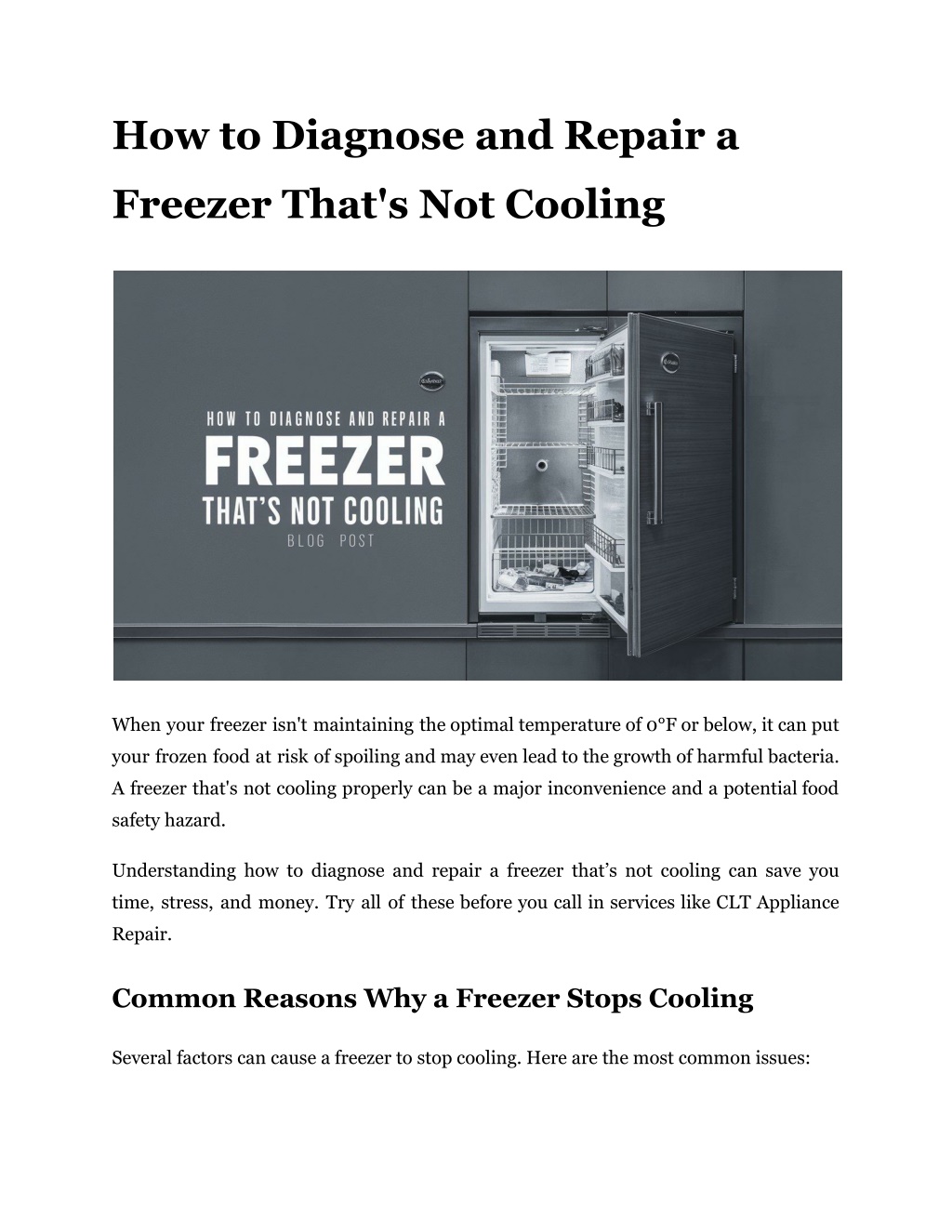
How to Diagnose and Repair a Freezer That's Not Cooling
Learn how to diagnose and repair your freezer if it's not cooling. Get step-by-step tips to keep your food fresh!
Download Presentation

Please find below an Image/Link to download the presentation.
The content on the website is provided AS IS for your information and personal use only. It may not be sold, licensed, or shared on other websites without obtaining consent from the author. Download presentation by click this link. If you encounter any issues during the download, it is possible that the publisher has removed the file from their server.
E N D
Presentation Transcript
How to Diagnose and Repair a Freezer That's Not Cooling When your freezer isn't maintaining the optimal temperature of 0 F or below, it can put your frozen food at risk of spoiling and may even lead to the growth of harmful bacteria. A freezer that's not cooling properly can be a major inconvenience and a potential food safety hazard. Understanding how to diagnose and repair a freezer that s not cooling can save you time, stress, and money. Try all of these before you call in services like CLT Appliance Repair. Common Reasons Why a Freezer Stops Cooling Several factors can cause a freezer to stop cooling. Here are the most common issues:
Power Supply Issues Diagnosis Check if the freezer is plugged in properly. Ensure the outlet is functioning by testing it with another device. Solution Securely plug in the freezer. If the outlet is faulty, try another one or contact an electrician. Thermostat Settings Diagnosis Check the thermostat settings inside the freezer. They might have been accidentally changed. Solution Adjust the thermostat to a colder setting. Ideally, the freezer should be set at 0 F (-18 C). Dirty Condenser Coils Diagnosis Locate the condenser coils, usually at the back or underneath the freezer. Inspect for dust and debris accumulation. Solution Unplug the freezer. Clean the coils with a vacuum cleaner or a coil cleaning brush.
Read More Articles: Top Ideas for an Unforgettable Riviera Maya Bachelorette Party Faulty Evaporator Fan Diagnosis Listen for the fan. If it s not running, it could be the issue. Check for ice buildup around the fan. Solution Defrost the freezer if there s ice buildup. If the fan is faulty, replace it. This may require professional assistance. Defrost System Problems Diagnosis Look for excessive frost buildup on the evaporator coils. Solution Manually defrost the freezer by unplugging it. If the defrost system (timer, heater, or thermostat) is malfunctioning, it needs to be replaced. Step-by-Step Guide to Diagnosing and Repairing Your Freezer Step 1: Initial Inspection Power Check: Ensure the freezer is plugged in and the outlet is working. Thermostat Check: Verify the thermostat is set to the correct temperature.
Door Seal Check: Inspect the door gasket for cracks or gaps that could let warm air in. Step 2: Cleaning and Maintenance Clean Condenser Coils: Dust and debris on condenser coils can cause the freezer to overheat and stop cooling. Clean them regularly. Check for Blocked Vents: Ensure no food items are blocking the air vents inside the freezer. Step 3: Testing and Monitoring We skipped the diagnosing and fixing part as we covered it in the previous section. However, when you are done with that, it s time for the following Monitor the Temperature: Use a freezer thermometer to ensure it maintains the correct temperature. Regular Maintenance: Keep up with routine maintenance to prevent future issues. Clean the Condenser Coils: Clean the coils every 6 months to ensure optimal heat dissipation. Avoid Overloading: Leave enough space between items to allow for proper airflow. Check the Door Seal: Regularly inspect the door seal for cracks or gaps and replace it if necessary. Defrost Regularly: If your freezer doesn't have an automatic defrost feature, manually defrost it every 6 months to prevent excessive ice buildup. Consider a Backup Power Source: In case of power outages, have a backup generator or cooler on hand to keep your freezer running and prevent food spoilage. Some Freezer Repair Tools and Equipment You Might Need
Multimeter: For testing electrical components. Vacuum Cleaner/Coil Brush: For cleaning condenser coils. Screwdrivers: For removing panels and accessing internal components. Replacement Parts: Such as fans, thermostats, and defrost timers. Read More Articles: The Ultimate Guide to Planning a Cancun Bachelor Party What A Professional Can Do While some freezer repair tasks can be done by a handy homeowner, there are certain situations where it's best to call in a professional appliance repair technician. One name you can rely on is CLT Appliance Repair & there are more! Compressor issues: A faulty compressor is a complex and potentially dangerous problem that requires specialized knowledge and tools to diagnose and repair safely. Electrical problems: If you suspect an electrical issue, such as a malfunctioning thermostat or control board, it's best to have a professional assess and repair the problem to avoid the risk of electric shock or further damage to the freezer. Refrigerant leaks: Refrigerant leaks can be difficult to detect and may require specialized equipment to locate and repair. Attempting to recharge the refrigerant without properly addressing the leak can lead to further problems. Warranty concerns: If your freezer is still under warranty, attempting repairs yourself may void the warranty. A professional technician can assess the problem and determine if the repair is covered under the warranty. Safety considerations: Some freezer repair tasks, such as working with electrical components or removing heavy parts, can be physically demanding and potentially dangerous. Professionals have the necessary training and equipment to perform these tasks safely Comparison Table: DIY vs. Professional Repair
Factor DIY Repair Professional Repair Cost Low cost) (mainly parts High parts) (service fees + Time Moderate Fast Skill Offered Level Basic to Intermediate Expert Success Rate Variable High The Wrap Up Diagnosing and repairing a freezer that s not cooling doesn t always require professional help. You can often identify and fix common issues yourself. However, if the problem persists or seems too complex, it s wise to contact a professional for freezer repair. Regular maintenance and timely repairs not only extend the lifespan of your freezer but also ensure your food remains safe and preserved. For more information and professional repair services, visit CLT Appliance Repair today. Stay cool and keep your freezer running efficiently! Site Article: How to Diagnose and Repair a Freezer That's Not Cooling




